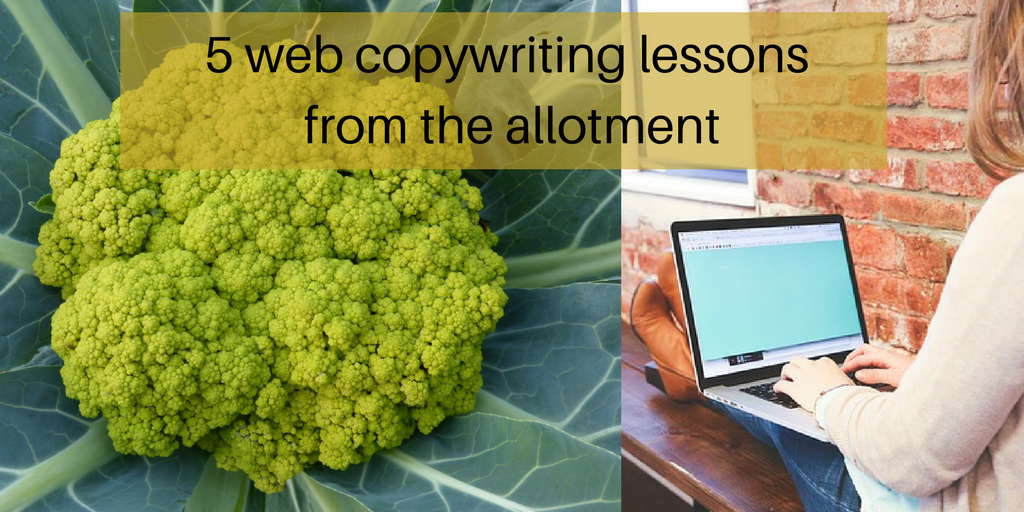Five web copywriting lessons from the allotment
Six years of waiting and we’ve finally got an allotment. It’s perfect timing – right at the start of the new growing season. Our plot is a lot bigger than I’d anticipated. At 250m2 you could easily park around 10 cars side by side along its length! It’s by no means a blank canvas having been well tended by one loving smallholder for the last 20 years. There are various crops growing including asparagus, rhubarb, leeks and several established fruit trees, with more still to be identified. It will need a lot of time and effort (and weeding!) for it to produce what we love to eat.
We’re not overwhelmed
Whilst at the allotment assessing the size of the plot and what needed to be done, I thought about my ‘white screen of death’ analogy. It’s that moment when you open a blank word document ready to write and your mind goes completely blank, with no idea where to start. It’s natural to feel that way when you face a new challenge. But we feel more excited than overwhelmed by our allotment situation. We’re going to make a plan and work out how to achieve our goals by taking small and frequent steps.
I use the same ‘white screen of death’ analogy when talking to people about writing blogs or web copy. Business owners often say they don’t know where to start when creating copy for their business website. Try not to feel overwhelmed. Think about what you want to achieve from your website and follow these small steps.
1. Clear the clutter
The first job on our allotment was clear all the rubbish and remove the rotten structures, so we could see exactly what we are dealing with. If you’re working on updating an existing website you can do the same. Review your content and decide what copy you’d like to keep or update for your redeveloped site. If you’re planning a brand new site, you could do some research instead. Make a list of your favourite websites and what you like about them. Your list will be invaluable for your web designer, even if it takes some narrowing down of wants and needs!
2. Make a plan
This is our work-in-progress. We’ve drawn a plan of our plot and started to write lists of fruit, veg and flowers we’d like to grow. Experts advise to only grow crops you like to eat so I’m in two minds whether to keep the four gooseberry bushes! It seems such a shame to dig them up.
In the online world your plan is your site structure or site map. This will look a little bit like an organisation chart and show which pages sit where on the site. A basic website structure might have five pages: Home, About, Services, Testimonials/Case Studies and Contact.
Talk to your developer about what you can achieve within your budget and discuss which pages you’ll need copy for. Ask whether there’s a limit to how much text you can have on the page because certain elements might have a character limit. The last thing you want is your beautifully crafted copy to be chopped off!
3. Think about keywords
There are certain key crops we want to produce in volume throughout the growing season - staple vegetables like potatoes, carrots and onions. Our plan is to designate areas to grow these, which is especially important if we’re going to achieve our aim of growing all the veggies for Christmas dinner this year!
With SEO being crucial in getting your website found, agree the keywords and search terms you want to identify with before you write the copy. Use your keywords and search terms (or variations of these) in the main heading and the first paragraph on your homepage. So if you want Google to find you by typing in ‘Cute children’s clothes, Warrington’ your heading and first sentence might read:
Cute children’s clothes shop based in Warrington, Cheshire
We sell a wide selection of cute and funky children’s clothes from our boutique in Warrington.
4. Write and edit
At the allotment we’ll sow more seeds than we can grow and choose the strongest seedlings to become our crop, getting rid of any weaker shoots. You can do the same with your copy. Write more than you need and edit it down to the key messages and meet your word count. It’s so much easier to write freely and without setting yourself any restrictive limits.
5. Share the wealth
Once your website is complete and live, let people know it’s there by sharing and promoting it on social media, newsletters and any other channels available to you. You cannot rely on Google to do all the work for you – get out there, tell people all about your wonderful new website and use it to grow your business.
We will definitely be sharing the wealth of the allotment with all our friends and family. The queue of eager fruit pickers is growing longer by the day!
